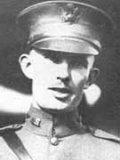|
Field
Kindley


Name: Field Eugene
Kindley
Country: United States
Rank: Captain
Services: United States Air Service
Units: 65 (RAF) 148th Aero (USAS)
Victories: 12
Date Of Birth: March 13, 1896
Place of Birth: Pea Ridge, Arkansas
Date Of Death: February 1, 1920
Place of Death: TexasKindley joined the Kansas National Guard in May of 1917.
Transferring to the U.S. Army's Signal Corps, he attended the
School of Military Aeronautics at the University of Illinois
before going to England for advanced flight training at Oxford. To
gain combat experience, he was assigned to the Royal Air Force's
65 Squadron on the Western Front on May 22, 1918.
Flying the Sopwith Camel, Kindley scored his first victory on
26 June 1918, shooting down a Pfalz D.III flown by the commanding
officer of Jasta 5, Wilhelm Lehmann. Reassigned to the 148th
Pursuit Squadron as a flight commander, Kindley's patrol engaged
Jasta 11 on August 13, 1918. That day, he scored his fourth
victory, shooting down a Fokker D.VII possibly flown by Lothar von
Richthofen who was wounded in the battle.
Promoted to Captain on February 24, 1919, Kindley assumed
command of the 94th Pursuit Squadron at Kelly Field in Texas in
January of 1920. Less than a month later, he was killed during
training manoeuvres when a control cable broke and his plane
crashed to the ground. His Sopwith Camel F.1, claimed to be the
only surviving Camel in the United States, was used during the
filming of "The Blue Max" in 1968. It is currently on loan to the
Aerospace Education Centre in Arkansas. Kindley Field in Bermuda
was named in his honour.
Distinguished Flying Cross (DFC)
"On September 24, 1918, Lt. Kindley led his flight down on seven
Fokkers north of Bourlon Wood, one of which he followed down and
saw crash and burst into flames. On September 26, 1918, while
working in conjunction with another of our flights, Lt. Kindley's
flight accounted for two EA crashed, one of which he got. On
September 27. 1918, this officer on low flying duty dropped bombs
on railways near Marcoing, then attacked a balloon near
Noyelles-sur-l'Escaut, driving same down and compelling the two
observers to jump. He then, at an altitude of 600 feet, attacked
and silenced an enemy machine gun and shot up troops. Being then
attacked by a Halberstadt, he engaged it and brought it down in
flames. Lt. Kindley's ammunition then being used up, he started
for the lines but on the way back, he saw two EA which he dived
on. They turned and went east. This officer has been on active
service in France since May 23, 1918. His work in this squadron
has been consistently good and since July 30, 1918, he has been
leading 'A' Flight with marked success. He has accounted for a
total of seven and one half EA destroyed and has driven down out
of control, three." DFC citation, London Gazette
Distinguished Service Cross (DSC)
"For extraordinary heroism in action near Bourlon Wood, France,
September 24, 1918. Lt. Kindley attacked a formation of seven
hostile planes (Fokker type) and sent one crashing to the ground."
DSC citation Distinguished Service Cross (DSC) Oak Leaf
Cluster
"For extraordinary heroism in action near Marcoing, France,
September 27, 1918. Flying at a low altitude, this officer bombed
the railway at Marcoing and drove down an enemy balloon. He then
attacked German troops at low altitude and silenced a hostile
machine gun after which he shot down in flames an enemy plane (Halberstadt
type) which had attacked him. Lt. Kindley has so far destroyed
seven and one half enemy aircraft and driven down three out of
control." DSC Oak Leaf Cluster citation. |
